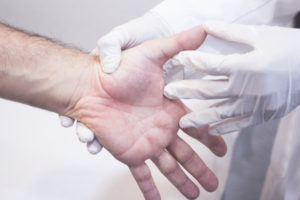Hand Fractures: Diagnosis and Treatment

We use our hands for almost everything we do, which means that our hands are prone to injury more so than other limbs on our bodies. Hand fractures occur for many reasons; automobile accidents, sports-related injuries, breaking a fall or certain medical conditions can easily break bones in the hands. But because fractures are relatively common, there are many ways for these injuries to be diagnosed and treated.
Diagnosing Hand Fractures
As soon as a fracture occurs, it’s important to seek medical treatment immediately. Leaving a hand fracture untreated can cause the bones to improperly align and create debilitating functionality. You will often know if you have broken a bone in your hand, as you will feel severe pain whenever you try to move it. Rather than attempt to mend the bone yourself, it’s best to visit a medical professional.
Your doctor will ask you a series of questions about how you sustained your. A physical examination of the hand will also be performed to gain a better understanding of the injury. The most conclusive way to determine the extent of the fracture is to take an X-ray. A CT or MRI may also be required depending on the type of fracture and injury
Treating Your Hand Fracture
The treatment that you receive for your hand fracture will depend on the severity of the damage as well as the location. If your bones have been broken but are still intact structurally, then a splint or a cast may be used to keep the bones set in place. However, if the bones have been displaced, then surgery might be needed to set the fragments and hold them together. Screws, pins and plates can be applied to the bone to ensure that it heals properly. Surgery might also be performed if multiple fractures have occurred or if there are damaged joints or ligaments. Additionally, external hardware can be placed on the hand if the location of the fracture is in an area where frequent movement occurs.
Hand fractures can also be painful during recovery, especially if surgery was performed, which is why pain relievers may be necessary to allow your hand to heal as comfortably as possible. Additional treatments include hand therapy, which is used if the functionality of your hand has been compromised. Once your cast or splint has been removed, rehabilitation exercises can help restore mobility to your hand.
If you would like more information about hand fractures or the treatments that are available to you, please contact Dr Damon Thomas on (03) 9034 7738 and schedule a consultation.
MAKING AN INFORMED DECISION
Our website is intended to provide general information about hand surgery and should not be used as a substitute for personalised medical advice. It is important to consult with a qualified plastic surgeon to determine if hand surgery is the right procedure for you. The following considerations should be part of your decision-making process.
Risks
All surgical procedures carry risk. The potential risks and complications associated with hand surgery include, but are not limited to, bleeding, infection, nerve damage, stiffness, loss of feeling or movement of the hand or fingers, scarring, and the need for additional surgery. It is important to understand the risks involved and weigh up the benefits and drawbacks of surgery before undergoing hand surgery.
Recovery
Recovery time after hand surgery may vary depending on the individual, the extent of the procedure, and the technique used. In general, patients should be prepared to experience some discomfort, swelling, and limited mobility after surgery. Patients must also be prepared to take time off work and other activities (including exercise) and follow post-operative instructions to promote proper healing and minimise the risk of complications.
Results
Individual results may vary depending on a number of factors, including the patient’s natural hand structure, the patient’s lifestyle, and the surgical technique employed. It is critical to have realistic expectations about the outcome of hand surgery and understand that each patient’s outcome will be unique. A physical therapy rehabilitation program after hand surgery is often crucial to regain function and improve range of motion.
If you have any questions or concerns about hand surgery, please do not hesitate to contact us.
